Body Force Model Implementation of Transonic Rotor for Fan/Airframe Simulations
Abstract
:1. Introduction
2. Methods
2.1. Body Force Model
2.2. Force Reconstruction
2.3. Validation Test Case
3. Results
3.1. Peak Efficiency Calibration Point
3.2. Off-Design Performance
3.3. Fan+OGV Stage
3.4. Installed Engine Operation
4. Conclusions
Funding
Data Availability Statement
Conflicts of Interest
Nomenclature
| BFM | Body force model |
| CFD | Computational fluid dynamics |
| OGV | Outlet guide vanes |
| RANS | Reynolds-averaged Navier–Stokes |
| SLC | Streamline curvature |
| TPR | Total pressure ratio |
| TTR | Total temperature ratio |
| Absolute circumferential flow angle, angle of attack | |
| Relative circumferential flow angle | |
| b | Blade metal blockage |
| c | Blade chord |
| Isentropic efficiency | |
| e | Specific total energy |
| Normal force | |
| Parallel force | |
| M | Mach number |
| Mass flow rate | |
| dynamic viscosity | |
| p | Static pressure |
| Total pressure | |
| r | Radial direction |
| Circumferential direction | |
| Density | |
| T | Static temperature |
| Blade maximum thickness | |
| Conservative variable vector | |
| u | Absolute velocity |
| w | Relative velocity |
| Flow coefficient | |
| Work coefficient | |
| z | Axial direction |
| Z | Number of cascade blades |
| Rotational speed |
Appendix A
References
- IATA. Aircraft Technology Roadmap to 2050; Report; IATA: Geneva, Switzerland, 2019. [Google Scholar]
- NLR; Economics, S.A. Destination 2050—A Route to Net Zero European Aviation; Report NLR-CR-2020-510; NLR—Royal Netherlands Aerospace Centre: Amsterdam, The Netherlands, 2021. [Google Scholar]
- Nickol, C.L.; Haller, W.J. Assessment of the performance potential of advanced subsonic transport concepts for NASA’s Eenvironmentally responsible aviation project. In Proceedings of the 54th AIAA Aerospace Sciences Meeting, San Diego, CA, USA, 4–8 January 2016; AIAA: Reston, VI, USA, 2016. [Google Scholar] [CrossRef] [Green Version]
- Carrier, G. Innovative engine integration solutions for transport aircraft: Current research and future challenges. Presented at the EUCASS 2017, Milano, Italy, 6 July 2017; EUCASS: Bruxelles, Belgium, 2017. [Google Scholar]
- Menegozzo, L.; Benini, E. Boundary Layer Ingestion Propulsion: A Review on Numerical Modeling. J. Eng. Gas Turbines Power 2020, 142, 120801. [Google Scholar] [CrossRef]
- Magrini, A.; Benini, E.; Yao, H.D.; Postma, J.; Sheaf, C. A review of installation effects of ultra-high bypass ratio engines. Prog. Aerosp. Sci. 2020, 119, 100680. [Google Scholar] [CrossRef]
- Hendricks, E.S. A Review of Boundary Layer Ingestion Modeling Approaches for Use in Conceptual Design; Report, NASA/TM—2018-219926; NASA: Washington, DC, USA, 2018.
- Gong, Y. A Computational Model for Rotating Stall and Inlet Distortions in Multistage Compressors. Ph.D. Thesis, Massachussets Institute of Technology, Cambridge, MA, USA, 1999. [Google Scholar]
- Peters, A. Ultra-Short Nacelles for Low Fan Pressure Ratio Propulsors. Ph.D. Thesis, Massachusetts Institute of Technology, Cambridge, MA, USA, 2014. [Google Scholar]
- Peters, A.; Spakovszky, Z.S.; Lord, W.K.; Rose, B. Ultrashort Nacelles for Low Fan Pressure Ratio Propulsors. J. Turbomach. 2014, 137, 21001. [Google Scholar] [CrossRef] [Green Version]
- Hall, D.K. Analysis of Civil Aircraft Propulsors with Boundary Layer Ingestion. Ph.D. Thesis, Massachusetts Institute of Technology, Cambridge, MA, USA, 2015. [Google Scholar]
- Hall, D.K.; Greitzer, E.M.; Tan, C.S. Analysis of fan stage conceptual design attributes for boundary layer ingestion. J. Turbomach. 2017, 139, 071012. [Google Scholar] [CrossRef] [Green Version]
- Akaydin, H.D.; Pandya, S.A. Implementation of a body force model in OVERFLOW for propulsor simulations. In Proceedings of the 35th AIAA Applied Aerodynamics Conference, Denver, CO, USA, 5–9 June 2017; American Institute of Aeronautics and Astronautics: Reston, VI, USA, 2017. [Google Scholar] [CrossRef] [Green Version]
- Thollet, W.; Dufour, G.; Carbonneau, X.; Blanc, F. Body-force modeling for aerodynamic analysis of air intake—Fan interactions. Int. J. Numer. Methods Heat Fluid Flow 2016, 26, 2048–2065. [Google Scholar] [CrossRef] [Green Version]
- Thollet, W.; Dufour, G.; Carbonneau, X.; Blanc, F. Assessment of body force methodologies for the analysis of intake-fan aerodynamic interactions. In Proceedings of the ASME Turbo Expo, Seoul, Republic of Korea, 13–17 June 2016. [Google Scholar] [CrossRef]
- Thollet, W. Body Force Modeling of Fan-Airframe Interactions. Ph.D. Thesis, Université de Tolouse—ISAE, Tolouse, France, 2017. [Google Scholar]
- Benichou, E.; Dufour, G.; Bousquet, Y.; Binder, N.; Ortolan, A.; Carbonneau, X. Body Force Modeling of the Aerodynamics of a Low-Speed Fan under Distorted Inflow. Int. J. Turbomach. Propuls. Power 2019, 4, 29. [Google Scholar] [CrossRef] [Green Version]
- Awes, A.; Dufour, G.; Daon, R.; Marty, J.; Barrier, R.; Carbonneau, X. Unsteady body force methodology for fan operability assessment under clean and distorted inflow conditions. In Proceedings of the AIAA Scitech 2021 Forum, Virtual, 11–15 January 2021; AIAA: Reston, VI, USA, 2021. [Google Scholar] [CrossRef]
- Godard, B.; Ben Nasr, N.; Barrier, R.; Marty, J.; Gourdain, N.; De Jaeghere, E. Methodologies for turbofan inlet aerodynamics prediction. In Proceedings of the 35th AIAA Applied Aerodynamics Conference, Denver, CO, USA, 5–9 June 2017; American Institute of Aeronautics and Astronautics: Reston, VI, USA, 2017. [Google Scholar] [CrossRef]
- Magrini, A.; Buosi, D.; Benini, E. Sensitivity analysis of nacelle intake high-incidence aerodynamics including a body force fan model. In Proceedings of the AIAA Scitech 2021 Forum, Virtual, 11–15 January 2021; AIAA: Reston, VA, USA, 2021. [Google Scholar] [CrossRef]
- Magrini, A.; Benini, E.; Buosi, D. Design of short intakes for ultra-high bypass engines: Preliminary exploration at fixed incidence. In Proceedings of the AIAA Scitech 2022 Forum, San Diego, CA, USA, 3–7 January 2022; AIAA: Reston, VA, USA, 2022. [Google Scholar] [CrossRef]
- Magrini, A.; Benini, E. Study of geometric parameters for the design of short intakes with fan modelling. Chin. J. Aeronaut. 2022, in press. [Google Scholar] [CrossRef]
- Magrini, A.; Buosi, D.; Benini, E. Assessment of engine modelling on the installed aerodynamics of an ultra-high bypass turbofan. In Proceedings of the AIAA Scitech 2022 Forum, San Diego, CA, USA, 3–7 January 2022; AIAA: Reston, VA, USA, 2022. [Google Scholar] [CrossRef]
- Chima, R.V.; Arend, D.J.; Castner, R.S.; Slater, J.W.; Truax, P.P. CFD models of a serpentine inlet, fan, and nozzle. In Proceedings of the 48th AIAA Aerospace Sciences Meeting Including the New Horizons Forum and Aerospace Exposition, Orlando, FL, USA, 4–7 January 2010; American Institute of Aeronautics and Astronautics: Reston, VI, USA, 2010. [Google Scholar] [CrossRef]
- Guo, J.; Hu, J. A three-dimensional computational model for inlet distortion in fan and compressor. Proc. Inst. Mech. Eng. Part A J. Power Energy 2018, 232, 144–156. [Google Scholar] [CrossRef]
- Hill, D.J.; Defoe, J.J. Innovations in Body Force Modeling of Transonic Compressor Blade Rows. Int. J. Rotating Mach. 2018, 2018, 6398501. [Google Scholar] [CrossRef]
- Mao, Y.; Dang, T.Q. A three-dimensional body-force model for nacelle-fan systems under inlet distortions. Aerosp. Sci. Technol. 2020, 106, 106085. [Google Scholar] [CrossRef]
- Pazireh, S.; Defoe, J.J. A New Loss Generation Body Force Model for Fan/Compressor Blade Rows: An Artificial-Neural-Network Based Methodology. Int. J. Turbomach. Propuls. Power 2021, 6, 5. [Google Scholar] [CrossRef]
- Cao, T.; Hield, P.; Tucker, P.G. Hierarchical immersed boundary method with smeared geometry. J. Propuls. Power 2017, 33, 1151–1163. [Google Scholar] [CrossRef]
- Cui, J.; Watson, R.; Ma, Y.; Tucker, P. Low order modeling for fan and outlet guide vanes in aero-engines. J. Turbomach. 2019, 141, 031002. [Google Scholar] [CrossRef] [Green Version]
- Burlot, A.; Sartor, F.; Vergez, M.; Méheut, M.; Barrier, R. Method comparison for fan performance in short intake nacelle. In Proceedings of the 2018 Applied Aerodynamics Conference, Atlanta, GA, USA, 25–29 June 2018; American Institute of Aeronautics and Astronautics: Reston, VI, USA, 2018. [Google Scholar] [CrossRef]
- Ma, Y.; Vadlamani, N.R.; Cui, J.; Tucker, P. Comparative studies of RANS versus large eddy simulation for fan-intake interaction. J. Fluids Eng. Trans. ASME 2019, 141, 031106. [Google Scholar] [CrossRef]
- Godard, B.; de Jaeghere, E.; Gourdain, N. Efficient design investigation of a turbofan in distorted inlet conditions. In Proceedings of the ASME Turbo Expo, Phoenix, AZ, USA, 17–21 June 2019; American Society of Mechanical Engineers (ASME): New York, NY, USA, 2019; Volume 2A-2019. [Google Scholar] [CrossRef] [Green Version]
- Adamczyk, J. Model Equation for Simulating Flows in Multistage Turbomachinery; Technical Report; NASA: Washington, DC, USA, 1984.
- Baralon, S.; Eriksson, L.E.; Hall, U. Evaluation of higher-order terms in the throughflow approximation using 3D Navier-Stokes computations of a transonic compressor rotor. In Proceedings of the Turbo Expo: Power for Land, Sea, and Air, Indianapolis, IN, USA, 7–10 June 1999; Volume 1. [Google Scholar] [CrossRef] [Green Version]
- Simon, J.; Thomas, J.P.; Léonard, O. On the Role of the Deterministic and Circumferential Stresses in Throughflow Calculations. J. Turbomach. 2009, 131, 031019. [Google Scholar] [CrossRef]
- Baralon, S.; Eriksson, L.E.; Håll, U. Validation of a throughflow time-marching finite-volume solver for transonic compressors. In Proceedings of the International Gas Turbine and Aeroengine Congress and Exhibition, Stockholm, Sweden, 2–5 June 1998. [Google Scholar] [CrossRef] [Green Version]
- Simon, J.F. Contribution to Throughflow Modelling for Axial Flow Turbomachine. Ph.D. Thesis, Université de Liège, Liège, Belgium, 2007. [Google Scholar]
- Magrini, A. Study of Body Force Modelling for Coupled Fan/Airframe Simulations. Ph.D. Thesis, Università Degli Studi di Padova, Padova, Italy, 2020. [Google Scholar]
- Marble, F. Three dimensional flow in turbomachines. In Volume X of High Speed Aerodynamics and Jet Propulsion; Hawthorne, W.R., Ed.; Princeton University Press: Princeton, NJ, USA, 1964. [Google Scholar]
- Tsoutsanis, P. Extended bounds limiter for high-order finite-volume schemes on unstructured meshes. J. Comput. Phys. 2018, 362, 69–94. [Google Scholar] [CrossRef]
- Roe, P.L.; Pike, J. Efficient construction and utilisation of approximate Riemann solutions. In Proceedings of the 6th International Symposium on Computing Methods in Applied Sciences and Engineering, VI, Versailles, France, 12–16 December 1983; North-Holland Publishing Co.: Amsterdam, The Netherlands, 1985; pp. 499–518. [Google Scholar]
- Toro, E.F. Riemann Solvers and Numerical Methods for Fluid Dynamics: A Practical Introduction; Springer: Berlin/Heidelberg, Germany, 2009; pp. 1–724. [Google Scholar] [CrossRef]
- Jalali, A.; Ollivier Gooch, C.F. Higher-order finite volume solution reconstruction on highly anisotropic meshes. In Proceedings of the 21st AIAA Computational Fluid Dynamics Conference, San Diego, CA, USA, 24–27 June 2013; American Institute of Aeronautics and Astronautics: Reston, VI, USA, 2013. [Google Scholar] [CrossRef]
- Ollivier-Gooch, C.; Van Altena, M. A High-Order-Accurate Unstructured Mesh Finite-Volume Scheme for the Advection–Diffusion Equation. J. Comput. Phys. 2002, 181, 729–752. [Google Scholar] [CrossRef]
- Spalart, P.R.; Allmaras, S.R. One-equation turbulence model for aerodynamic flows. Rech. Aérosp. 1994, 1, 5–21. [Google Scholar] [CrossRef]
- Allmaras, S.R.; Johnson, F.T.; Spalart, P.R. Modifications and clarications for the implementation of the spalart-allmaras turbulence model. In Proceedings of the International Conference on Computational Fluid Dynamics, Tokyo, Japan, 9–10 January 2012. [Google Scholar]
- Podboy, G.G.; Krupar, M.J.; Hughes, C.E.; Woodward, R.P. Fan Noise Source Diagnostic Test—LDV Measured Flow Field Results; Technical Report; NASA Glenn Research Center: Cleveland, OH, USA, 2003.
- Hughes, C.E.; Jeracki, R.J.; Woodward, R.P.; Miller, C.J. Fan Noise Source Diagnostic Test—Rotor Alone Aerodynamic Performance Results; Technical Report; NASA Glenn Research Center: Cleveland, OH, USA, 2005.
- Van Zante, D.E.; Podboy, G.G.; Miller, C.J.; Thorp, S.A. Testing and Performance Verifi cation of a High Bypass Ratio Turbofan Rotor in an Internal Flow Component Test Facility; Technical Report; NASA Glenn Research Center: Cleveland, OH, USA, 2009.
- Ansys, I. ANSYS CFX-Solver Theory Guide; Ansys, Inc.: Canonsburg, PA, USA, 2018. [Google Scholar]
- ASME. Procedure for Estimation and Reporting of Uncertainty Due to Discretization in CFD Applications. J. Fluids Eng. 2008, 130, 78001. [Google Scholar] [CrossRef] [Green Version]
- Barth, T.; Jespersen, D. The design and application of upwind schemes on unstructured meshes. In Proceedings of the 27th Aerospace Sciences Meeting, Reno, NV, USA, 9–12 January 1989. [Google Scholar] [CrossRef]
- Ansys, I. ANSYS Fluent User Manual; Ansys, Inc.: Canonsburg, PA, USA, 2018. [Google Scholar]
- Magrini, A.; Buosi, D.; Benini, E. Analysis of ultra-high bypass ratio turbofan nacelle geometries with conventional and short intakes at take-off and cruise. In Proceedings of the ASME Turbo Expo 2022, Rotterdam, The Netherlands, 13–17 June 2022. [Google Scholar] [CrossRef]
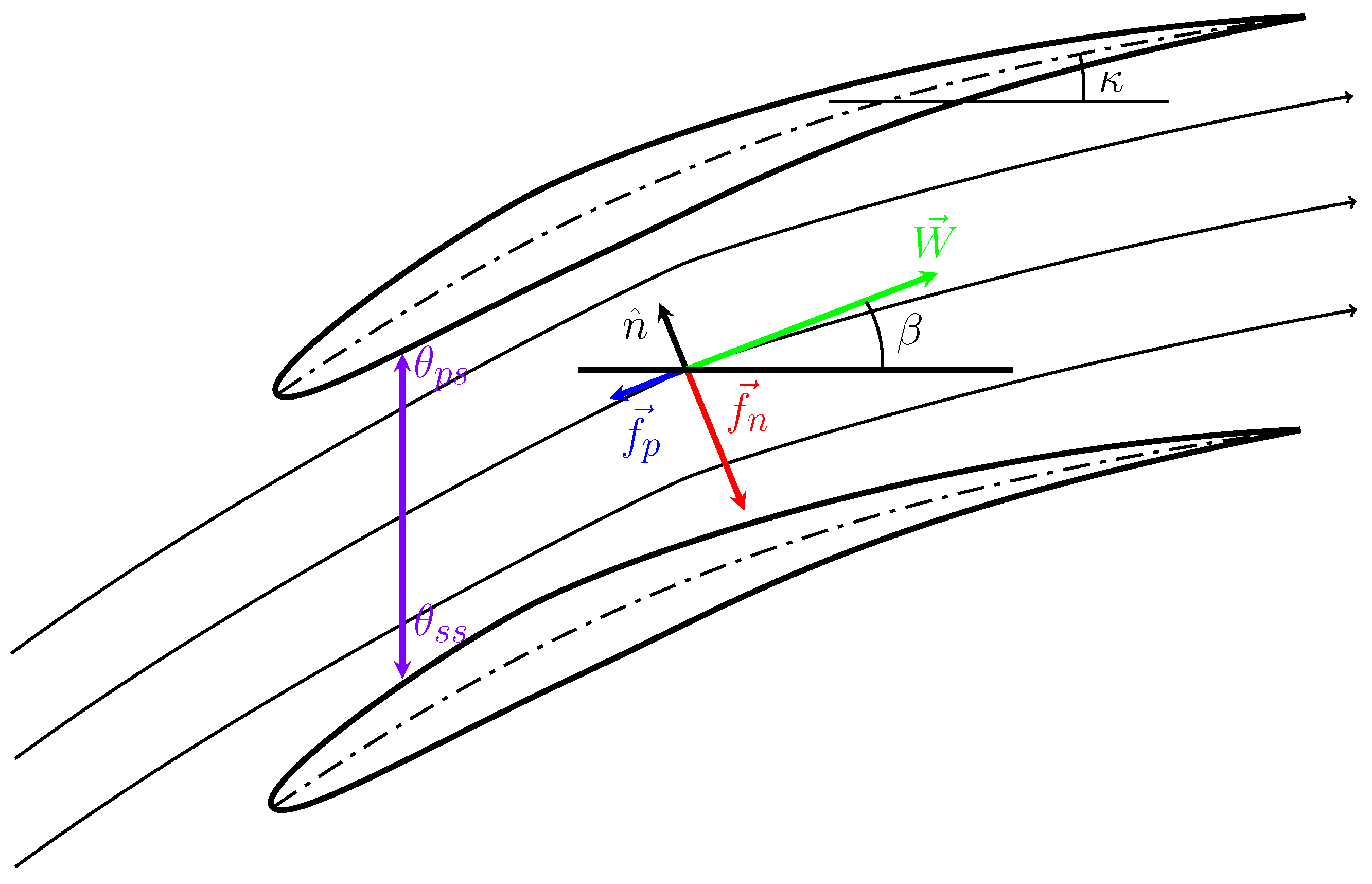
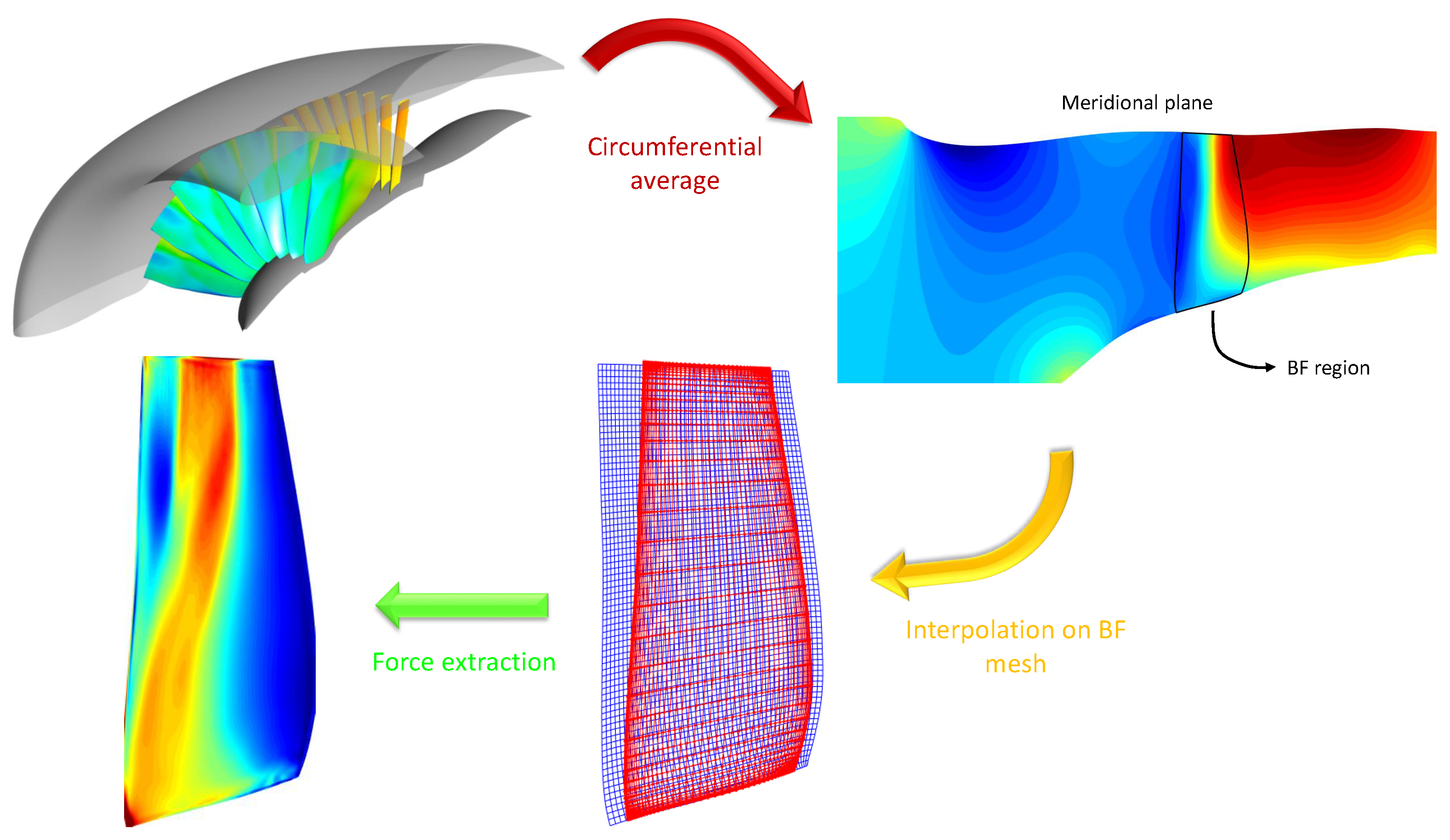
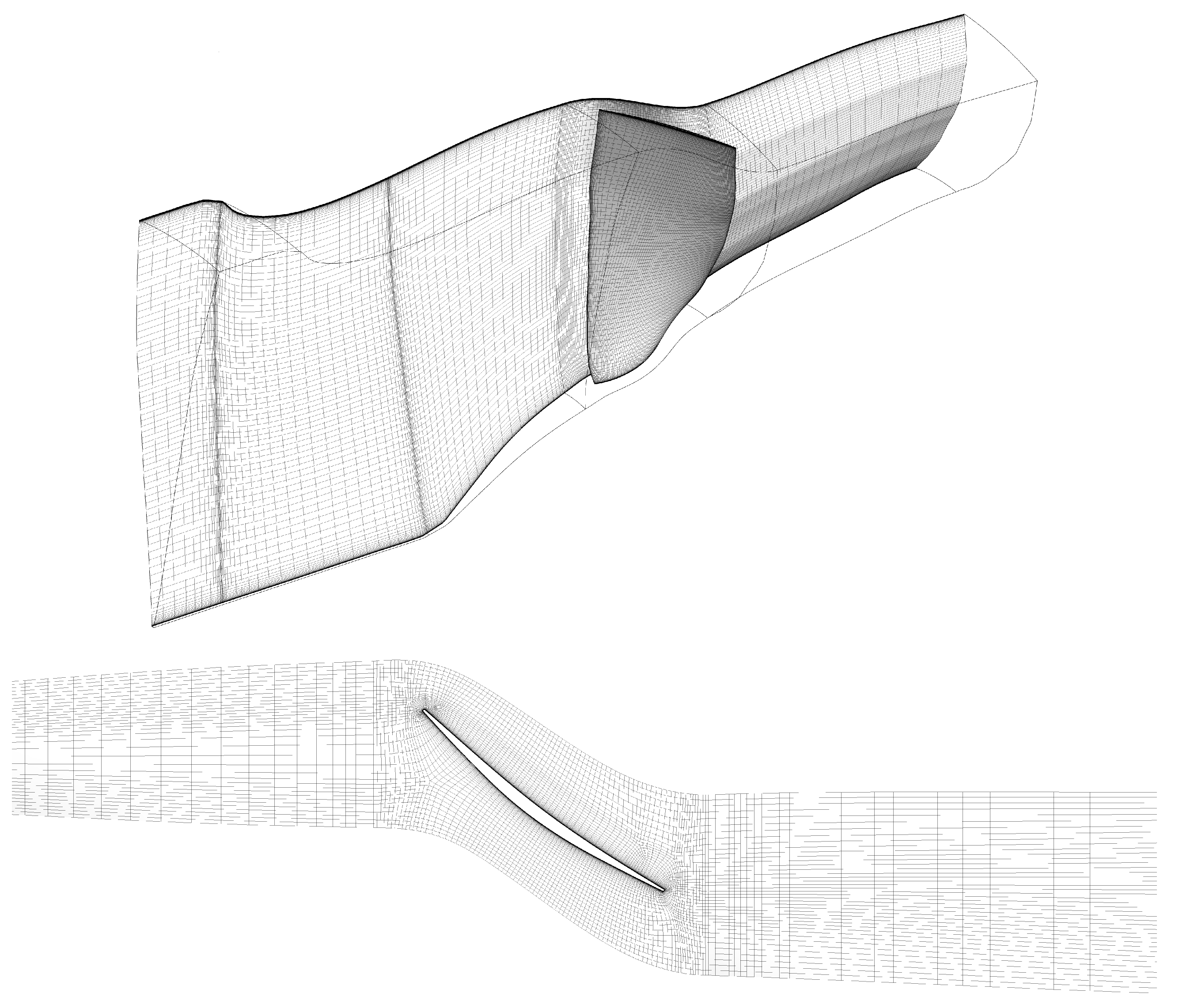
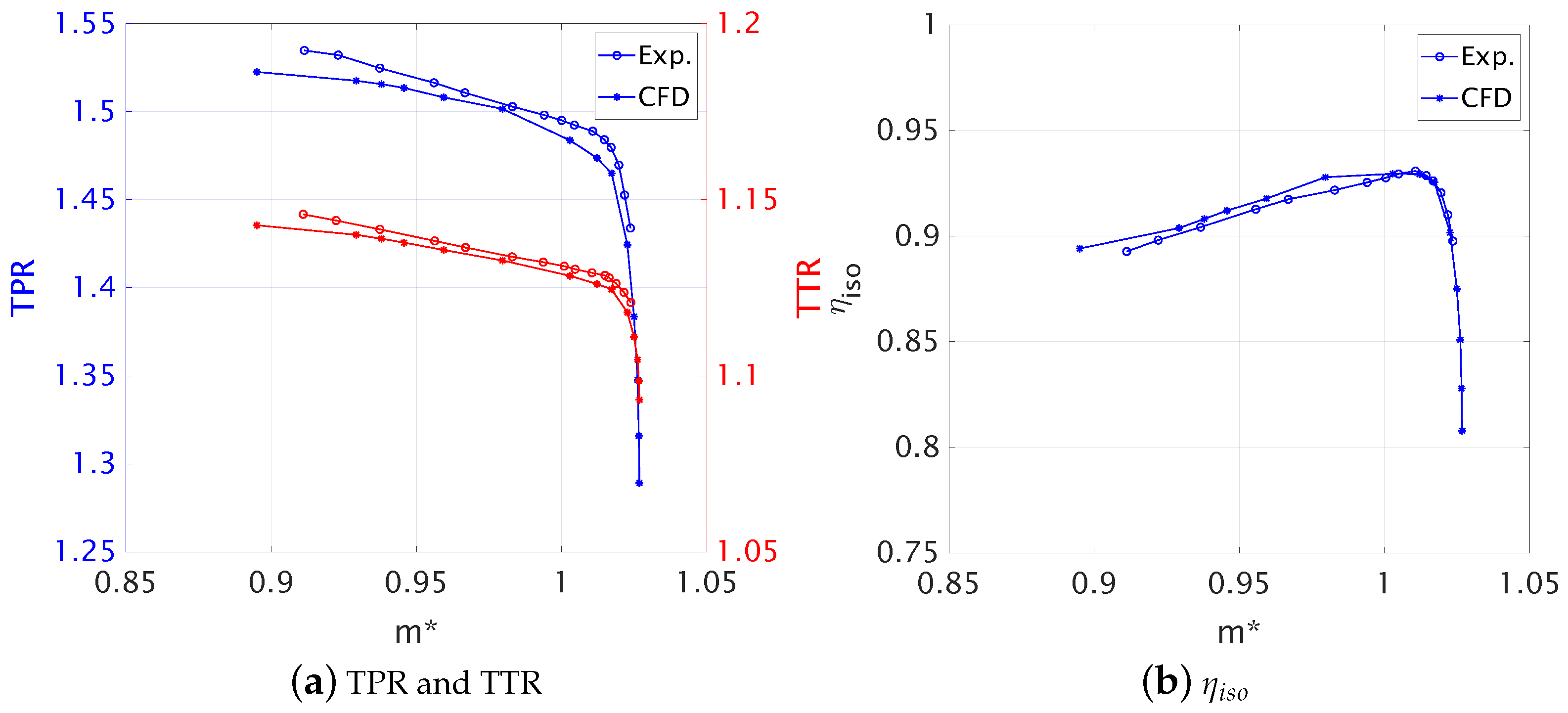


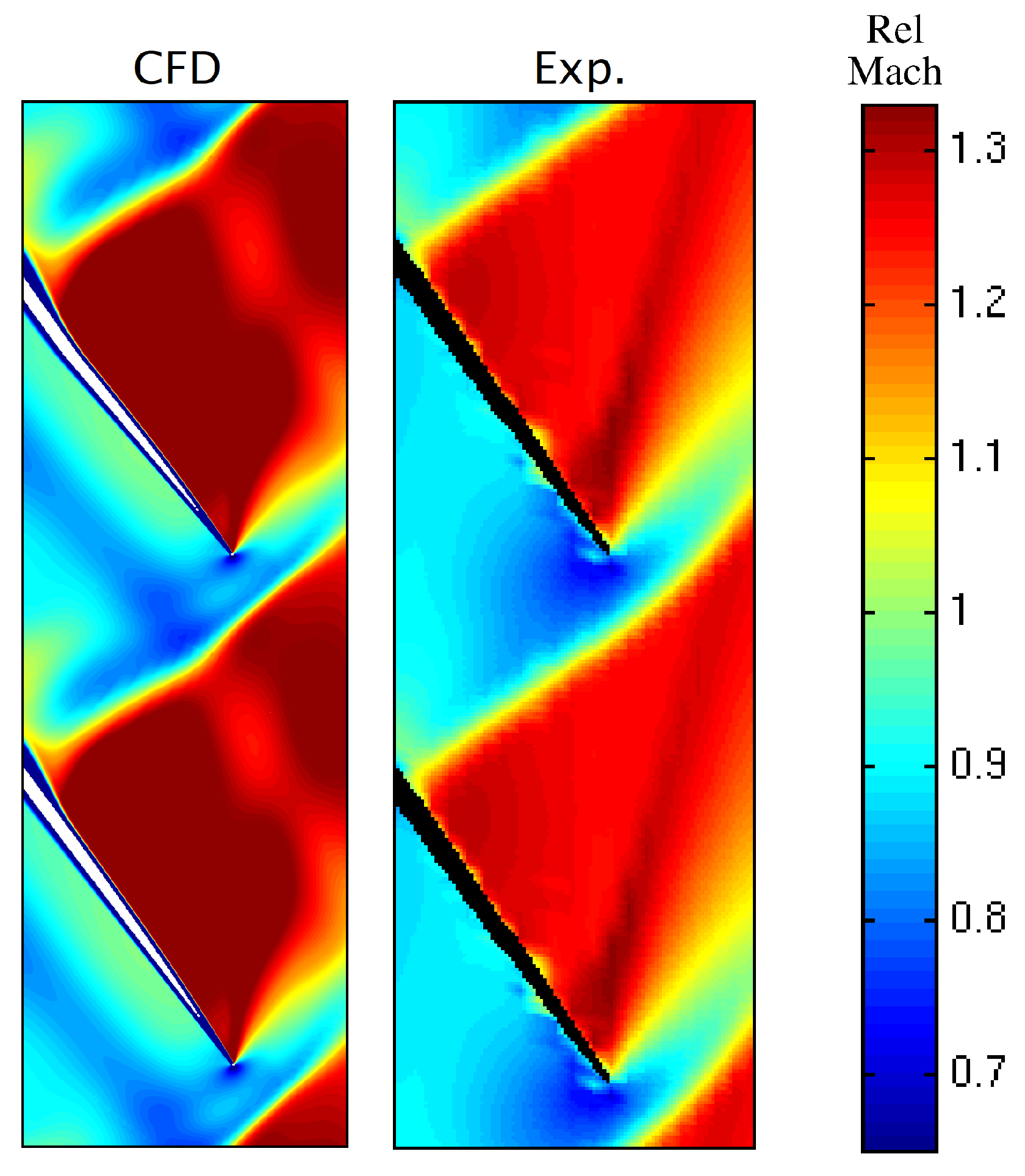

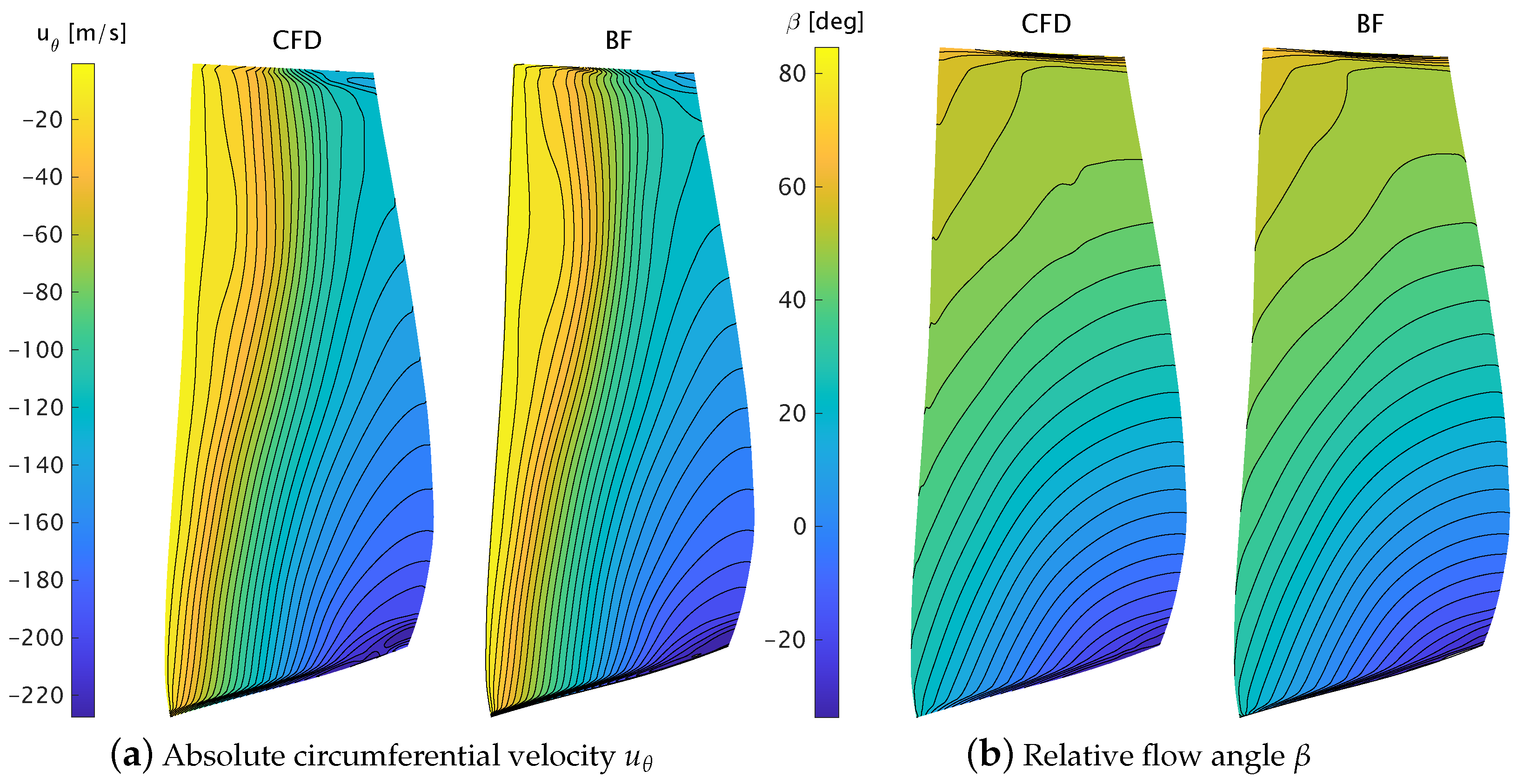

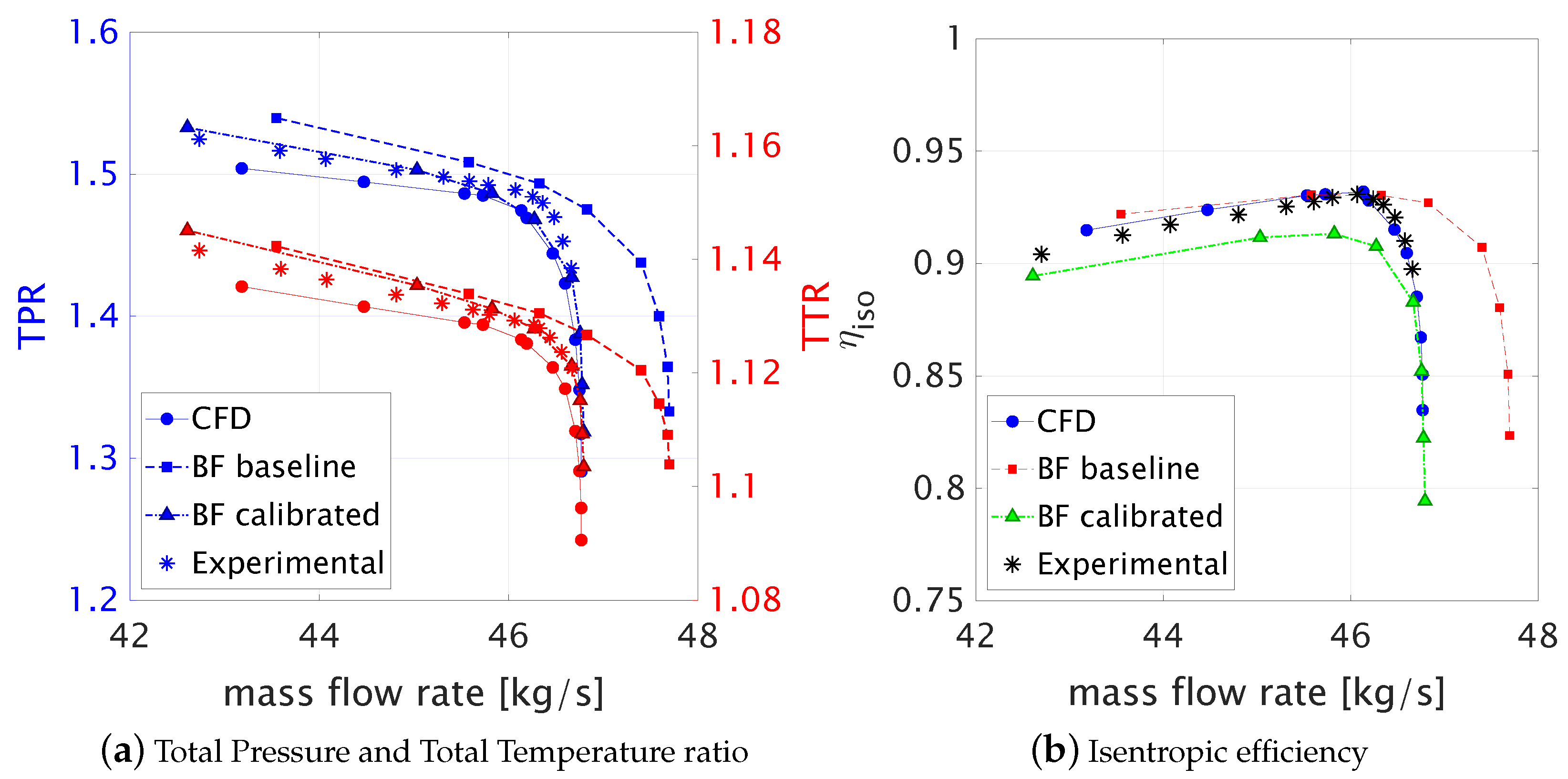

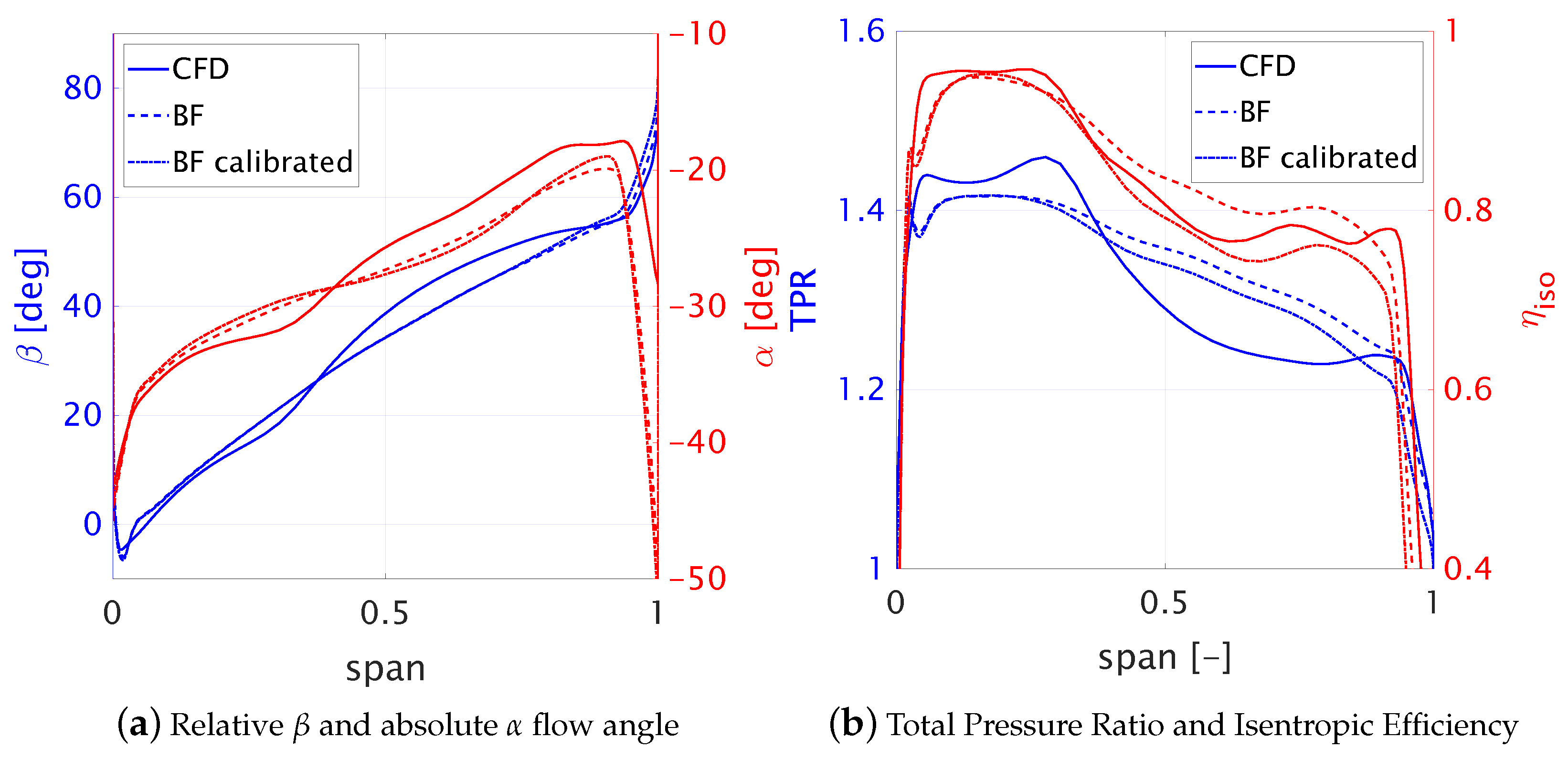
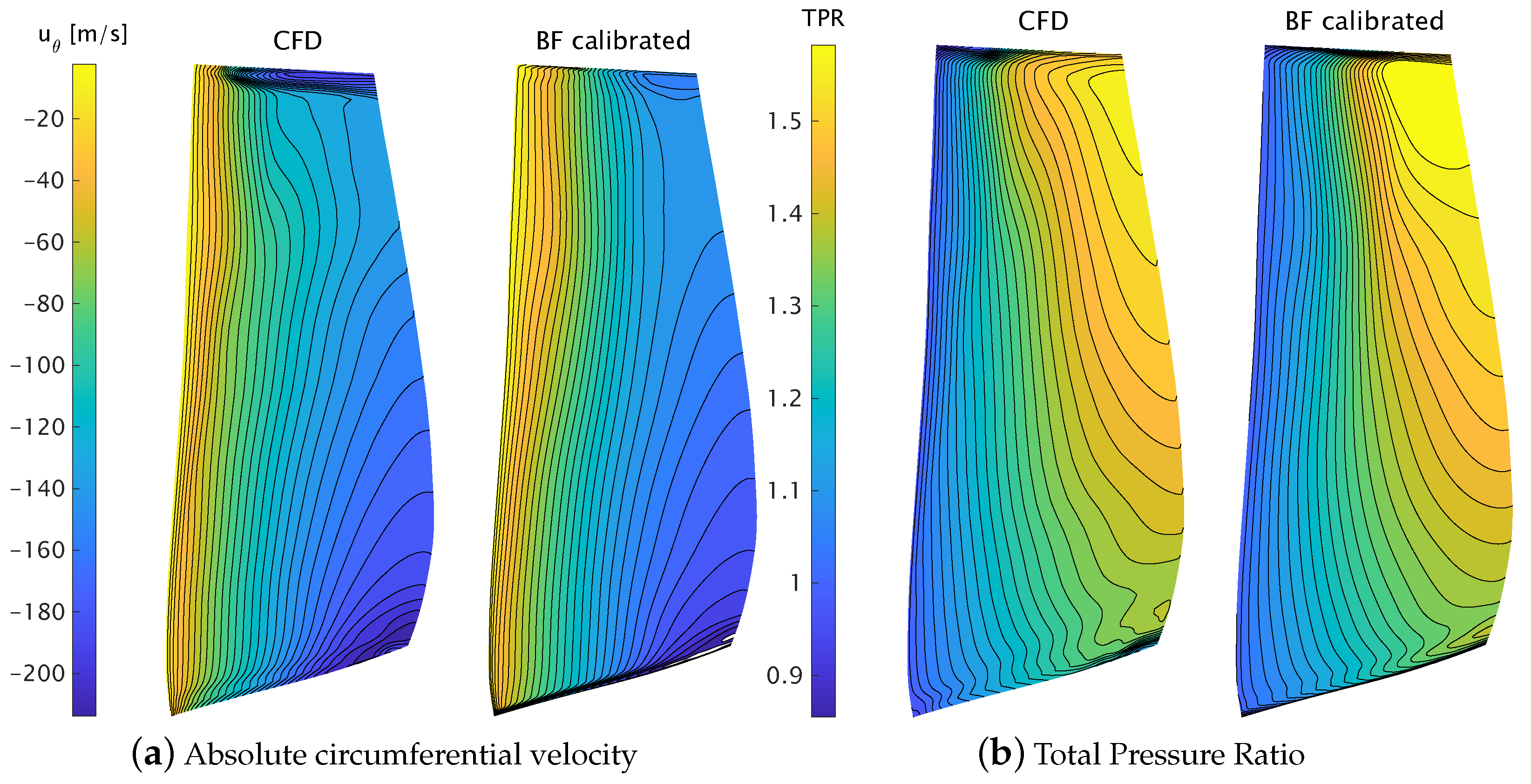

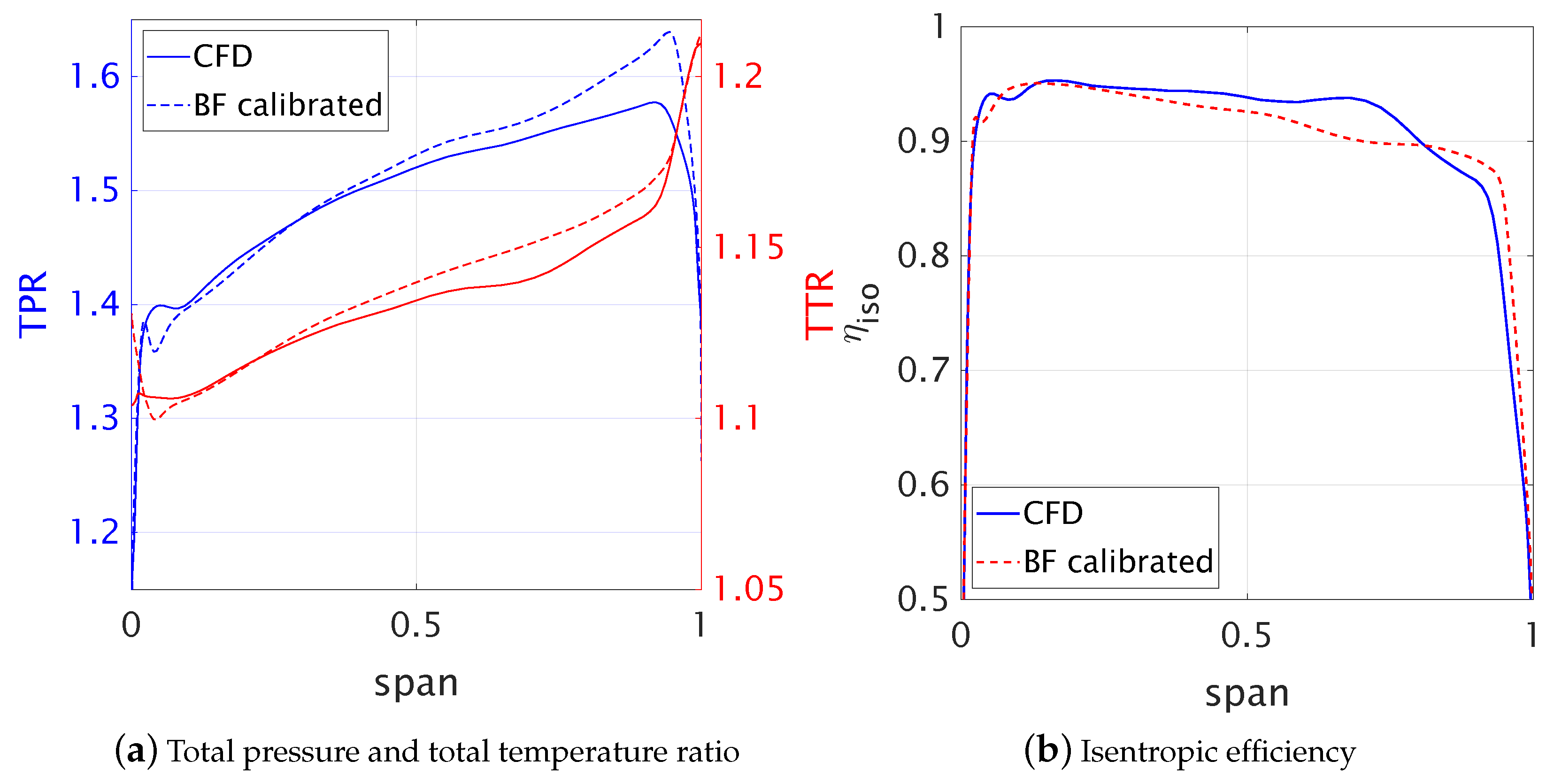
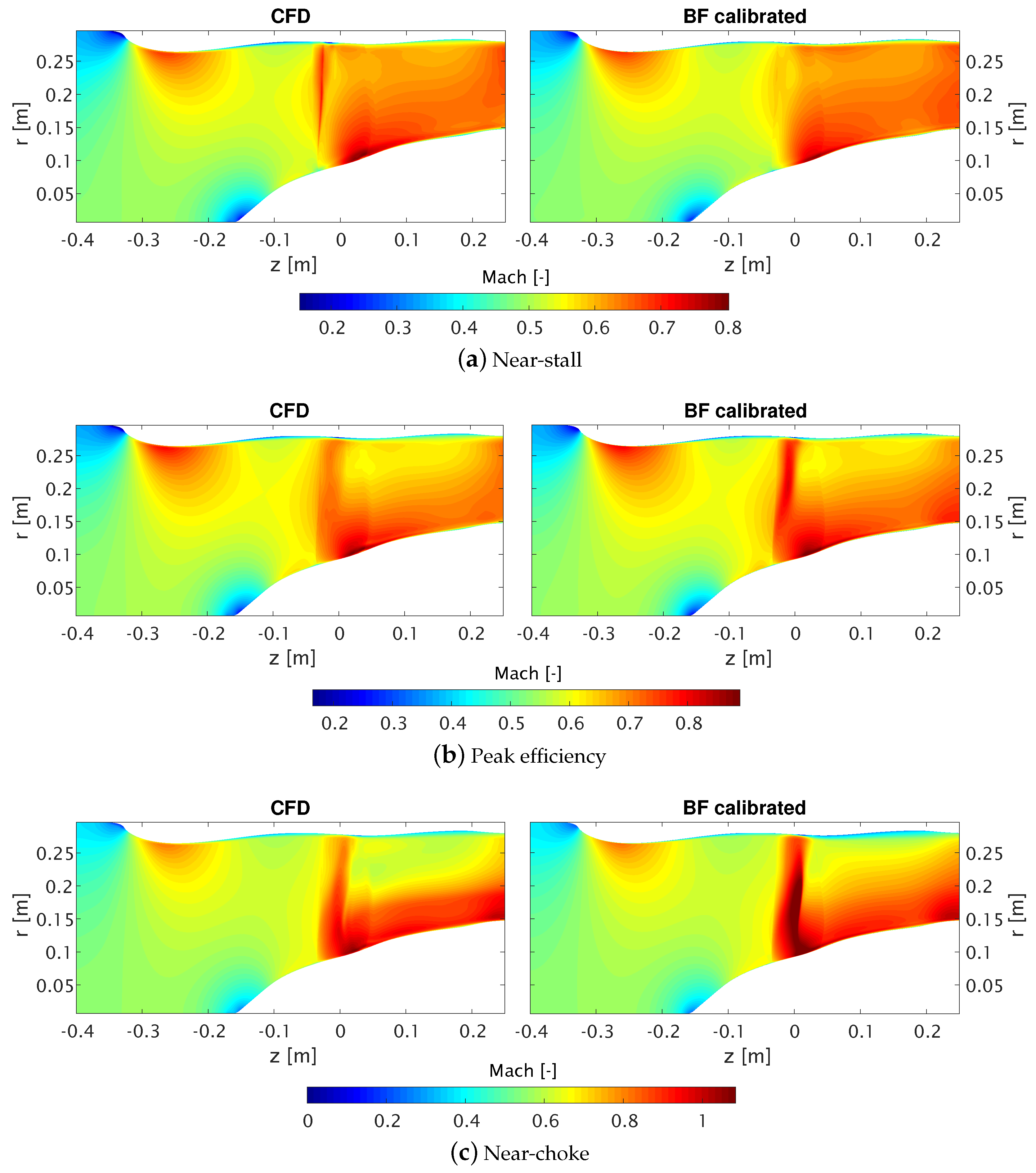




| Fan | OGV Baseline | |
|---|---|---|
| No Blades | 22 | 54 |
| Aspect Ratio | 2.0 | 3.51 |
| Hub/Tip ratio | 0.30 | 0.50 |
| Chord (mm) | 91.694 | 39.878 |
| Solidity | 1.73 | 1.52 |
| Stagger (deg) | 37.10 | 10.29 |
| tip | 0.028 | 0.0698 |
| [kg/s] | TPR | TTR | ||
|---|---|---|---|---|
| Exp. | 44.09 | 1.511 | 1.136 | 91.7 % |
| CFD | 44.07 | 1.510 | 1.1357 | 92.1 % |
| Model | Swirl [deg] | [kg/s] | TPR | TTR | |
|---|---|---|---|---|---|
| BF | +5 | 47.465 | 1.478 | 1.133 | 0.890 |
| CFD | +5 | 47.276 | 1.474 | 1.129 | 0.906 |
| BF | −5 | 44.653 | 1.452 | 1.123 | 0.916 |
| CFD | −5 | 44.476 | 1.448 | 1.119 | 0.934 |
| TPR | TTR | |||
|---|---|---|---|---|
| (BFM-CFD) | 0.091 | −0.001 | 0.002 | −0.014 |
| (BFM- CFD)/CFD [%] | 0.20 | 0.068 | 0.177 | −1.55 |
Publisher’s Note: MDPI stays neutral with regard to jurisdictional claims in published maps and institutional affiliations. |
© 2022 by the author. Licensee MDPI, Basel, Switzerland. This article is an open access article distributed under the terms and conditions of the Creative Commons Attribution (CC BY) license (https://creativecommons.org/licenses/by/4.0/).
Share and Cite
Magrini, A. Body Force Model Implementation of Transonic Rotor for Fan/Airframe Simulations. Aerospace 2022, 9, 725. https://doi.org/10.3390/aerospace9110725
Magrini A. Body Force Model Implementation of Transonic Rotor for Fan/Airframe Simulations. Aerospace. 2022; 9(11):725. https://doi.org/10.3390/aerospace9110725
Chicago/Turabian StyleMagrini, Andrea. 2022. "Body Force Model Implementation of Transonic Rotor for Fan/Airframe Simulations" Aerospace 9, no. 11: 725. https://doi.org/10.3390/aerospace9110725
APA StyleMagrini, A. (2022). Body Force Model Implementation of Transonic Rotor for Fan/Airframe Simulations. Aerospace, 9(11), 725. https://doi.org/10.3390/aerospace9110725






